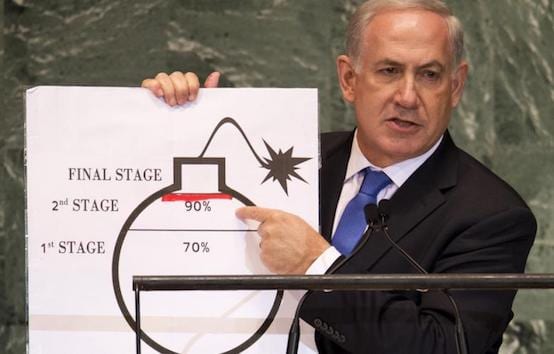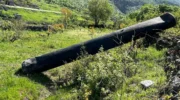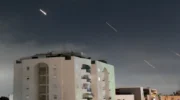Israeli Prime Minister Benjamin Netanyahu at UN in 2012. (You Tube)
Author Gareth Porter and Veteran Intelligence Professionals for Sanity report that Trump recently cancelled the Iran Deal based on documents obtained via Israeli intelligence.
“The evidence presented by Israeli Prime Minister Benjamin Netanyahu on April 30 alleging a covert Iranian nuclear weapons program shows blatant signs of fabrication. That evidence is linked to documents presented by the Bush Administration more a decade earlier as proof of a covert Iran nuclear weapons program. Those documents were clearly fabricated as well.
“We sent President Bush a similar warning about bogus intelligence — much of it fabricated by Israel —six weeks before the U.S./UK attack on Iraq, but Bush paid us no heed. This time, we hope you will take note before things spin even further out of control in the Middle East. In short, Israel’s ‘new’ damaging documents on Iran were fabricated by the Israelis themselves.”
Read two articles below:
VIPS Call on Trump Not to Pull Out of Iran Nuclear Deal
From Consortium News, May 7, 2018
As Donald Trump announces his decision at 2 pm Tuesday on staying in the Iran nuclear deal, the Veteran Intelligence Professionals for Sanity urge him in this memo exclusive to Consortium News not to base his decision on fabricated evidence.
MEMORANDUM FOR: The President
FROM: Veteran Intelligence Professionals for Sanity (VIPS)
SUBJECT: Being “Played” By Bogus Evidence on Iran
NOTE: The evidence presented by Israeli Prime Minister Benjamin Netanyahu on April 30 alleging a covert Iranian nuclear weapons program shows blatant signs of fabrication. That evidence is linked to documents presented by the Bush Administration more a decade earlier as proof of a covert Iran nuclear weapons program. Those documents were clearly fabricated as well.
We sent President Bush a similar warning about bogus intelligence — much of it fabricated by Israel —six weeks before the U.S./UK attack on Iraq, but Bush paid us no heed. This time, we hope you will take note before things spin even further out of control in the Middle East. In short, Israel’s “new” damaging documents on Iran were fabricated by the Israelis themselves.
Executive Summary
The Bush administration account of how the documents on Iran got into the hands of the CIA is not true. We can prove that the actual documents originally came not from Iran but from Israel. And the documents were never authenticated by the CIA or the International Atomic Energy Agency (IAEA).
Two former Directors-General of the IAEA, Hans Blix and Mohamed ElBaradei, have publicly expressed suspicion that the documents were fabricated. And forensic examination of the documents yielded multiple signs that they are fraudulent.
We urge you to insist on an independent inquiry into the actual origins of these documents. We believe that the renewed attention being given to claims that Iran is secretly working to develop nuclear weapons betokens a transparent attempt to stoke hostility toward Iran, with an eye toward helping “justify” pulling out of the 2015 nuclear deal with Iran.
* * *
Mr. President,
We write you in the hope that you will be informed of our views before you decide whether to continue to adhere to the Joint Comprehensive Plan of Action (JCPOA) regarding Iran. We fear that upcoming decisions may be based, in part, on unreliable documents alleging secret nuclear weapons activity in Iran.
On April 30, Israeli Prime Minister Netanyahu displayed some of those documents in his slide show on what he called the Iranian “atomic archive.” But those are precisely the same fraudulent documents that were acquired by the CIA in 2004.
The official accounts offered by the senior officials of the CIA about the provenance of these documents turned out be complete fabrication. Journalists were told variously that the documents (1) were taken from the laptop computer of an Iranian working in a secret research program; (2) were provided by a German spy; or (3) simply came from a “longtime contact in Iran.”
However, Karsten Voigt, the former German Foreign Office official in charge of German-North American cooperation, revealed in an on the record interview with historian/journalist Gareth Porter in 2013 that senior officials of the German foreign intelligence service, the BND, told Voigt in November 2004 that the documents had been passed to the CIA by a BND source. That source, the senior BND official said, was not considered trustworthy, because he belonged to the Mujahideen-E-Khalq (MEK), the armed Iranian opposition group that was known to have served as a conduit for information that Israeli intelligence (Mossad) wanted to provide to the IAEA without having it attributed to Israel. (In 2012 Secretary of State Hillary Clinton removed MEK from the list of terrorist organizations.)
Voigt recalled that the senior BND officials told him of their worry that the Bush administration was going to repeat the error of using fraudulent intelligence, as was the case with the notorious “Curveball”, the Iraqi living in Germany, whom the BND had identified as unreliable. Nonetheless, Curveball’s fictions about mobile biological weapons laboratories in Iraq —with “artists renderings” by the CIA of those phantom labs — had been used by Colin Powell in his error-ridden presentation to the UN on February 5, 2003, leading to war on Iraq.
As for the purported Iranian documents, the CIA never ruled out the possibility that they were fabricated, and the IAEA made no effort to verify their authenticity. IAEA Director General Mohamed ElBaradei recalled in his memoirs that he had believed the documents were not really from the Iranian government and that, as he put it, “it made more sense that this information originated in another country.” ElBaradei stated publicly from 2005 through 2009 that the documents had not been authenticated, and he refused to use them as “evidence” of a covert Iranian weapons research program. And ElBaradei’s predecessor as Director-General, Hans Blix, hassaid he is “somewhat more worried” about the intelligence on the alleged Iranian nuclear weapons program than about the dubious intelligence he saw on Iraq, because “there is as much disinformation as there is information.”
Each of the documents mentioned by both Netanyahu and the IAEA reports bears tell-tale signs of fraud. The most widely reported document in the collection is a set of schematic drawings showing efforts to redesign the re-entry vehicle of Iran’s Shahab-3 missile to accommodate a nuclear weapon. But the slide that Netanyahu displayed on the screen in his slide show provides visual confirmation of fraud. The drawing shows clearly the “dunce cap” design of the Shahab-3 reentry vehicle. But Iran’s Defense Ministry had already discarded that “dunce cap” reentry vehicle when it began to develop a new improved missile. That redesign began in 2000, according to theCongressional testimony in September 2000 of CIA national intelligence officer for strategic and nuclear programs Robert D. Walpole. But the earliest dates of any of the alleged Iranian nuclear weapon program documents on the project for redesign of the reentry vehicle in the May 2008 IAEA report on the entire collection are from summer 2002 after the “dunce cap” was replaced. The “baby-bottle” shaped reentry vehicle on the redesigned missile was not known to the outside world until the first test of the new missile in mid-2004. So those drawings could not have been done by someone who was actually involved in the redesign of the original Shahab-3 reentry vehicle; it was clearly the work of a foreign intelligence agency seeking to incriminate Iran, but slipping up on one important detail and thus betraying its fraudulent character.
The second document from that same collection turned over to the IAEA that has been widely reported is the so-called “green salt project” — a plan for a bench-scale system of uranium conversion for enrichment given the code name “Project 5.13” and part of a larger “Project 5”. Other documents that had been provided by the MEK showed that “Project 5” also included a sub-project involving ore processing at a mine designated “Project 5.15,” according to a briefing by IAEA Deputy Director Olli Heinonen in February 2008.
But when Iran turned over detailed documents to the IAEA in response to its questions about Project 5.15 in 2008, the IAEA learned the truth: there had been a real ore processing project called Project 5.15, but it was a civilian project of the Atomic Energy Organization of Iran – not part of a covert nuclear weapons program—and the decision to create Project 5.15 had been made on August 25, 1999—more than two years before the initial date of the project found in the collection of supposedly secret nuclear weapons research documents. That fact gives away the ruse surrounding the numbering system of “Project 5″ adopted by intelligence specialists who had fabricated the document.
A third document that purportedly shows Iranian nuclear weapons research is about what Netanyahu called “Multi-Point Initiation in hemispheric geometry” and the IAEA called “experimentation in connection with symmetrical initiation of a hemispherical high explosive charge suitable for an implosion type nuclear device.” Significantly, that document was not part of the original collection that the CIA had passed to the IAEA, but had been given to the IAEA years later, and officials from the IAEA, Europe and the United States refused to reveal which member country had provided the document. Former Director-General ElBaradei revealed in his memoirs, however, that Israel had passed a series of documents to the IAEA in 2008-09, in an effort to make the case that Iran had continued its nuclear weapons experiments until “at least 2007.”
The summary picture we offer above includes unusually clear evidence of the fraudulent nature of the documents that are advertised as hard evidence of Iran’s determination to obtain nuclear weapons. One remaining question is cui bono? — who stands to benefit from this kind of “evidence.” The state that had the most to gain from the fabrication of such documents was obviously Israel.
Completely absent from the usual discussion of this general problem is the reality that Israel already has a secret nuclear arsenal of more than a hundred nuclear weapons. To the extent Israel’s formidable deterrent is more widely understood, arguments that Israel genuinely fears an Iranian nuclear threat any time soon lose much of their power. Only an extreme few suggest that Iran’s leaders are bent on risking national suicide. What the Israelis are after is regime change in Tehran. And they have powerful allies with similar aims.
We therefore urge you, Mr. President, not to go along with these plans or to decide to pull the U.S. out of the six-nation nuclear deal with Iran based on fraudulent evidence.
For the Steering Group, Veteran Intelligence Professionals for Sanity (VIPS)
Richard H. Black, Senator of Virginia, 13th District; Colonel US Army (ret.); Former Chief, Criminal Law Division, Office of the Judge Advocate General, the Pentagon (associate VIPS)
Marshall Carter-Tripp, Foreign Service Officer (ret.) and Division Director, State Department Bureau of Intelligence and Research
Kathleen Christison, Senior Analyst on Middle East, CIA (ret.)
Philip Giraldi, CIA, Operations Officer (ret.)
Matthew Hoh, former Capt., USMC, Iraq & Foreign Service Officer, Afghanistan (associate VIPS)
Michael S. Kearns, Captain,Wing Commander, RAAF (ret.); Intelligence Officer & ex-Master SERE Instructor
John Kiriakou, former CIA Counterterrorism Officer and former senior investigator, Senate Foreign Relations Committee
Edward Loomis, NSA Cryptologic Computer Scientist (ret.)
David MacMichael, Ph.D., former senior estimates officer, National Intelligence Council (ret.)
Ray McGovern, former US Army infantry/intelligence officer & CIA analyst; CIA Presidential briefer (ret.)
Elizabeth Murray, former Deputy National Intelligence Officer for the Near East, National Intelligence Council & CIA political analyst (ret.)
Todd E. Pierce, MAJ, US Army Judge Advocate (ret.)
Gareth Porter, author/journalist (associate VIPS)
Scott Ritter, former MAJ., USMC, former UN Weapon Inspector, Iraq
Coleen Rowley, FBI Special Agent and former Minneapolis Division Legal Counsel (ret.)
Robert Wing, former Foreign Service Officer (associate VIPS)
Ann Wright, Colonel, US Army (ret.); also Foreign Service Officer who resigned in opposition to the US war on Iraq
This Memorandum was drafted by VIPS Associate Gareth Porter, author of “Manufactured Crisis: The Untold Story of the Iran Nuclear Scare,” 2014
Was There Ever an Iranian Nuclear Weapons Program?
By Gareth Porter, The American Conservative
Donald Trump’s decision to pull out of the Joint Comprehensive Plan of Action (JCPOA), which has set the stage for another Iran crisis, has opened a new round of domestic political struggle, as Democrats in Congress, the anti-Trump television networks, and the tattered remains of the old anti-war movement try to push back.
But that effort has a fatal weakness at its core. It concedes to Trump and opponents of the Iran deal an effective argument: that the Iranians have been lying when they say they’ve never had a covert nuclear weapons program. The theme of Iran’s duplicity has been the emotional core of the assault on the JCPOA. It is no accident that the title and consistent theme of Benjamin Netanyahu’s melodramatic YouTube slideshow was “Iran lied.”
As I detail in my investigative history of the Iran nuclear issue, the Obama administration itself fell for a false narrative about a secret Iranian nuclear weapons program allegedly in operation from 2001 to 2003. After Netanyahu’s April 30 show, former secretary of state John Kerry tweeted: “Every detail PM Netanyahu presented yesterday was every reason the world came together to apply years of sanctions and negotiate the Iran nuclear agreement—because the threat was real and had to be stopped.”
But a far more effective counter would have been the truth—that the long-accepted accusation about Iran’s covert nuclear weapons program is the product of an elaborate disinformation operation based on documents forged by Mossad, Israel’s foreign intelligence agency.
In mid-2004, the CIA acquired a massive set of documents that were said to have come from a secret Iranian nuclear weapons research program. Bush administration officials leaked a sensational story to selected news outlets about the intelligence find, describing to the New York Times what that newspaper described as Iranian drawings “trying to develop a compact warhead to fit atop its Shahab missile.” The same story of Iran mating a nuclear weapon to its longer-range ballistic missile was given to the Washington Post and the Wall Street Journal.
But both the real provenance of the apparently incriminating documents and specific details about the documents themselves indicate that they are fraudulent. A major clue about the papers’ true origins was made public in November 2004, when Karsten Voigt, the coordinator for German-North American cooperation in the German Foreign Office, was quoted by the Wall Street Journal warning that the documents had been provided by “an Iranian dissident group,” and that the United States and Europe “shouldn’t let their Iran policy be influenced by single-source headlines.”
Voigt was clearly suggesting that the mysterious documents had come from the Iranian regime-hating MEK (Mujahideen-e-Khalq)—not from someone in the purported Iranian arms program. But no one in the corporate media universe followed up with Voigt, and it was not until 2013, three years after he’d retired from the Foreign Office, that he agreed to give this writer the story behind his warning.
Voigt recalled how senior officials of the Bundesnachtrichtendienst, or BND, the German foreign intelligence agency, had told him just days before the Wall Street Journal interview that they were upset Secretary of State Colin Powell had referred publicly to “evidence” that Iran had tried to design a new missile to carry a nuclear weapon. Voigt explained that the documents to which Powell was alluding had been turned over to the BND by an Iranian who had been a sometime source—but not a BND spy, contrary to later accounts in the Wall Street Journal and Der Spiegel.
In fact, he said, the BND did not regard the source as trustworthy, because they knew he was a member of the MEK, the exiled armed Iranian opposition group. The MEK is listed by the State Department as a terrorist organization because of its assassination of U.S. officers during the Shah’s regime and its bombings of public events after the Islamic Revolution in Iran. The MEK also carried out “special operations” for Saddam Hussein’s regime in Iraq against domestic opposition during the Iran-Iraq war, and after that had been used by Israel’s Mossad to “launder” information that it wanted to make public but didn’t want attributed to Israel, according to two Israeli journalists. The MEK had pinpointed the location of Iran’s Natanz enrichment facility in August 2002. But it had gotten the satellite intelligence from Mossad, as Seymour Hersh reported in his 2005 book Chain of Command.
Two years before Voigt’s conversation with BND officials, then-BND director August Hanning personally warned CIA director George Tenet to be cautious about using the testimony of the infamous Iraq “Curveball” source regarding Iraqi bioweapons because it could not be independently confirmed. Other BND analysts said that “Curveball” was unreliable. Powell had nevertheless used the information in his infamous United Nations speech justifying the coming invasion of Iraq in March 2003.
Two years later, BND officials were afraid history was about to be repeated in Iran. Germany had just joined France and Britain in reaching an accord with Tehran, which was aimed at averting a U.S. move to take the Iran file out of the IAEA and create a new crisis at the UN Security Council over the issue of the nuclear program.
But it wasn’t just the provenance of the MEK documents that was suspect. Their authenticity was never clearly established by the CIA, which could not rule out the possibility of falsification, according to the Washington Post. Mohamed ElBaradei, then director-general of the IAEA, was put under heavy political pressure by a U.S.-led coalition to publish a report endorsing those documents as evidence against Iran. But Elbaradei responded to the pressure by declaring in an October 2009 interview, “The IAEA is not making any judgment at all whether Iran even had weaponization studies before because there is a major question of authenticity of the documents.”
Benjamin Netanyahu gave the public its first view of the documents on which the Bush administration had heavily relied to sway Elbaradei, showing in his slideshow a surprisingly crude schematic drawing of a Shahab-3 missile reentry vehicle with a circle representing a nuclear weapon. What is important to note about that image is that the shape of the reentry vehicle is the “dunce cap” shape of the original missile that Iran had acquired from North Korea in the mid-1990s. As early as 2000, the CIA’s national intelligence officer on Iranian missiles testified that Iran had already begun redesigning the Shahab-3 missile for better performance. But the outside world was in the dark about what the redesign would look like until the new missile was given its first test flight in August 2004. That test revealed that the redesigned reentry vehicle had a “tri-conic” or “baby bottle” shape.
However, the 36-page document of which the image shown by Netanyahu was a part, called “Implementation of Mass Properties of Shahab-3 Missile Warhead with New Payload,” was dated March-April 2003—long after the redesign of the reentry vehicle had taken place—as the IAEA’s May 2008 report shows on page two of its annex. The inescapable conclusion is that the authors of those drawings were not working for a project of the Iranian Defense Ministry but for a foreign intelligence agency, which guessed wrongly that the shape of Iran’s missile would not change fundamentally.
Lastly,* we have “Project 5,” another alleged project listed in the Iranian weapons program documents, supposedly involving uranium ore mining and conversion of uranium ore for enrichment. One of the sub-projects, designated “Project 5.15”, was for “ore concentration.” But when the IAEA accessed the original documents from Iran in response to its questions, it found that the contract for a “Project 5.15” for ore concentration had been signed not by a secret nuclear weapons project but by the civilian Atomic Energy Organization of Iran, which was in fact responsible for all activities relating to Iranian uranium ore mines. Furthermore, the IAEA found that the project document had been signed in August 1999—two years before the start date of the alleged secret nuclear weapons research project. When this writer confronted former IAEA Deputy Director Olli Heinonen about the contradiction, he admitted that he could not explain it.
The Israeli role in the creation of evidence of Iran’s nuclear weapons ambitions didn’t end with the papers delivered by the MEK. In 2008-09, Israel turned over more alleged Iranian documents to the IAEA, including a report on experiments with “multi-point initiation” of a nuclear explosion, which Netanyahu emphasized in his recent YouTube presentation. The IAEA and the U.S.-led coalition of states that dominated it of course refused to identify the member state that had provided those documents, but ElBaradei revealed in his memoirs that the state was indeed Israel.
The historical impact of the Israelis getting U.S. national security, political, and media elites to accept that these fabrications represented genuine evidence of Iran’s nuclear duplicity can hardly be understated. It has unquestionably been one of history’s most successful—and longest running—disinformation campaigns. But it worked without a hitch, because of the readiness of those elites to believe without question anything that was consistent with their perceived interests in continued enmity toward Iran.





